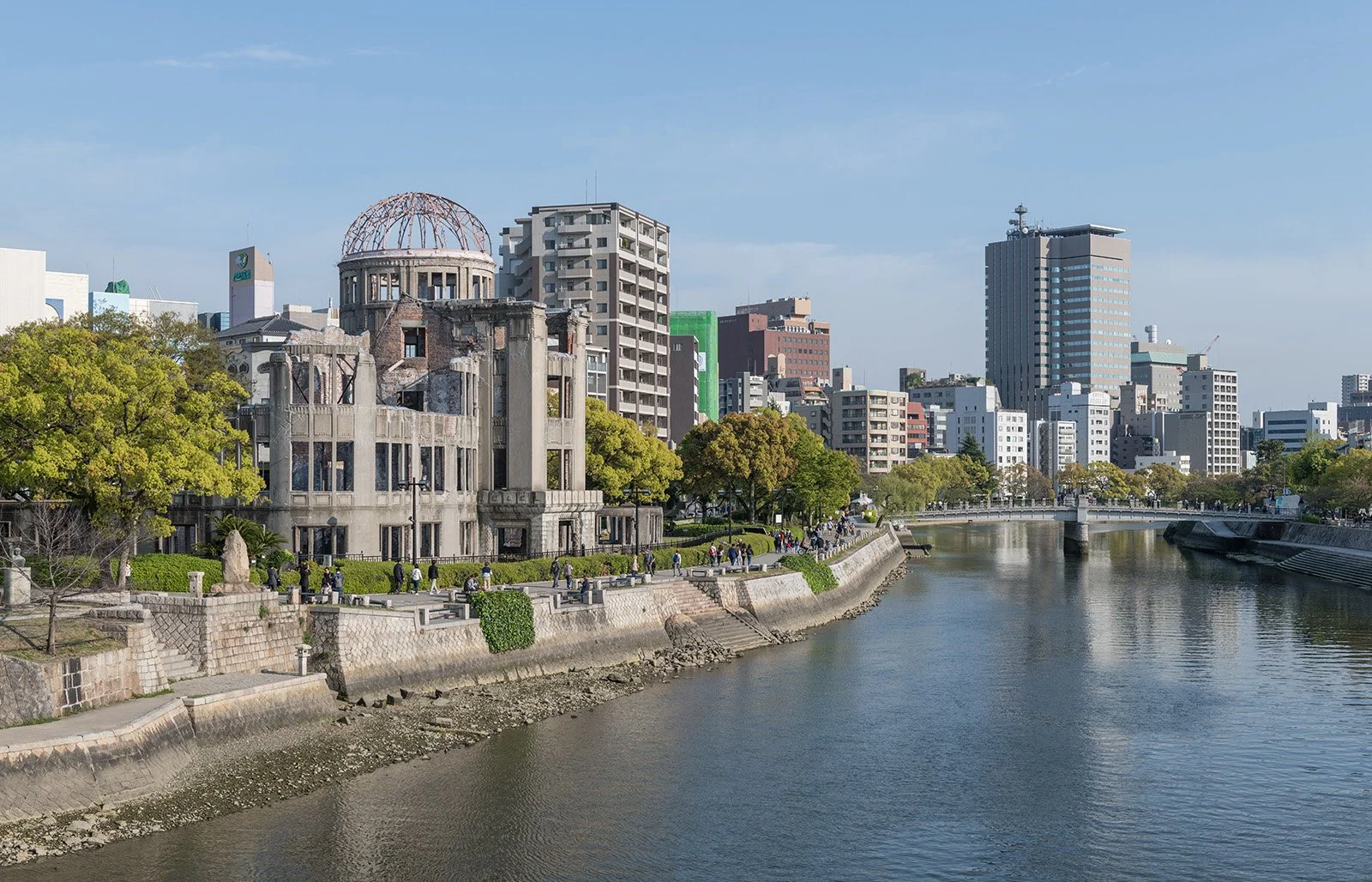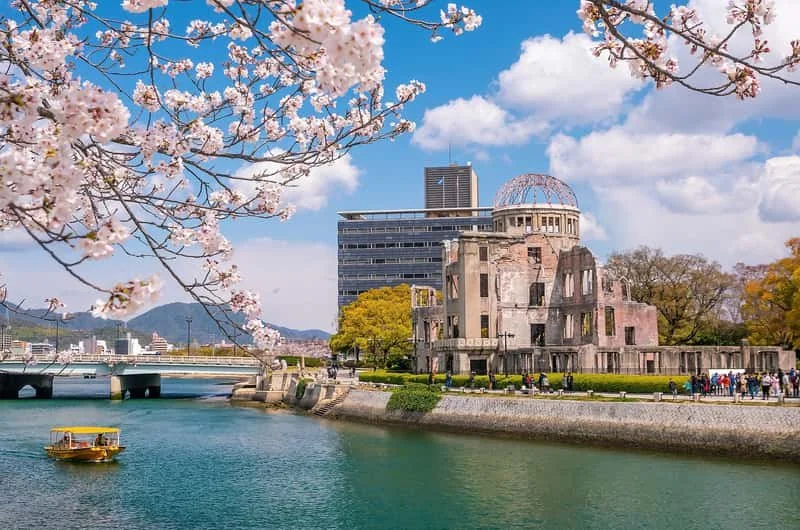HIROSHIMA - 80 YEARS SINCE THE ATOMIC BOMB
Hiroshima today. https://commons.wikimedia.org/wiki/User:DXR
HIROSHIMA - 80 YEARS SINCE THE ATOMIC BOMB
Text by Max
At 08:15 on 6 August 1945, the quiet of Hiroshima was shattered by a single flash of light. In an instant, the first atomic bomb ever used in war detonated 580 metres above the city, releasing a force equivalent to around 15,000 tonnes of TNT. The bomb, nicknamed Little Boy, was dropped from the B-29 bomber Enola Gay and changed the course of history forever.
THE MORNING OF THE ATTACK
Before that morning, Hiroshima was a bustling city of more than 300,000 people. It served as a key military and logistics hub, yet had been largely untouched by the devastating firebombings that had levelled many Japanese cities. Children were on their way to school, workers heading to their jobs, and families beginning another day of wartime hardship. No one imagined that within seconds their world would be reduced to fire and ashes.
When the bomb detonated, the temperature at the core of the explosion reached several million degrees Celsius. A blinding white light was followed by a shockwave that flattened buildings up to five kilometres away. Glass melted. Steel beams twisted as if they were made of paper. Nearly every wooden house in the city was incinerated instantly.
HUMAN LOSS AND SUFFERING
Around 78,000 people died immediately. Thousands more would succumb to their injuries and radiation sickness in the days, weeks, and months that followed. By the end of 1945, the death toll had reached an estimated 140,000. Over the following decades, cancers and chronic illnesses caused by radiation exposure claimed tens of thousands more lives. Today, the total number of dead is believed to be close to 350,000.
Most of the victims were civilians, children, the elderly, and forced labourers brought from Korea. Survivors, the hibakusha, told stories of unimaginable suffering. Many were burned so badly that their skin hung in strips. Others staggered silently through the rubble, seeking water in a city where everything had been scorched. Parents carried lifeless children. Countless families were torn apart in a moment. For years, survivors faced not only illness and trauma but also social stigma, as many feared they carried a “nuclear curse”.
One survivor, Keiko Ogura, was just eight years old that morning. She recalled emerging from a tunnel to a city that “looked like hell”, with people so badly burned that “you couldn’t tell if they were human”. She remembered the “shadows of vanished people” etched into pavements by the bomb’s heat, haunting imprints that remain to this day.
Keiko Ogura. Photo : Darrell Miho
WHY HIROSHIMA?
The decision to drop the bomb remains one of history’s most controversial acts. President Truman’s administration argued it was necessary to force Japan’s surrender and avoid a bloody invasion of the Japanese mainland, which military planners estimated could cost millions of lives on both sides. In his diary, Truman justified the order as a way to “save 500,000 American lives”.
Yet even at the time, not everyone in Washington agreed. Admiral William Leahy, Truman’s Chief of Staff, later called the bomb “barbarous” and argued that Japan was already defeated. Dwight D. Eisenhower would later write that he believed it was “not necessary to strike them with that horrible thing”.
Historians have long debated whether the bombings were truly the only path to ending the war. Japan’s cities had already been devastated by conventional bombing and naval blockades. On 8 August, just two days after Hiroshima, the Soviet Union entered the war against Japan, invading Manchuria with overwhelming force. Some scholars argue that Truman sought to end the war before the Soviets gained further influence in Asia, ensuring a post-war order shaped by American rather than Soviet power.
As historian Tsuyoshi Hasegawa has argued, “It was not Hiroshima or Nagasaki that caused Japan to surrender. It was the Soviet Union’s entry into the war.” This view challenges the long-held American narrative that the atomic bomb alone ended World War II.
Hiroshima’s status as an untouched city also played a role. It allowed the U.S. to assess the bomb’s full destructive impact with grim precision. While the stated purpose was to end the war swiftly, the attack also served as a real-world test of nuclear warfare’s consequences, a fact that later fuelled ethical condemnation worldwide.
JAPANESE LEADERSHIP’S RESPONSE
Contrary to popular belief, Japan did not immediately surrender after Hiroshima. Some members of the Japanese Supreme War Council argued that the bombing was no worse than the firebombing of Tokyo. It was only after the Nagasaki bombing on 9 August and the Soviet declaration of war that Emperor Hirohito intervened, breaking the military deadlock and announcing Japan’s surrender on 15 August 1945. This timeline fuels the ongoing debate over whether Hiroshima alone would have ended the war.
THE AFTERMATH AND REBIRTH
In the ruins of Hiroshima, only a few structures survived, most famously the Genbaku Dome, once the city’s Industrial Promotion Hall. It still stands today as part of the Hiroshima Peace Memorial, preserved exactly as it was after the explosion. The city itself has been completely rebuilt. From a landscape of ashes rose modern streets, schools, parks, and homes. Today, Hiroshima is home to over a million people and has become a global centre for peace advocacy.
The Hiroshima Peace Memorial Park now occupies the heart of the city, with the Peace Memorial Museum chronicling the horrors of nuclear war. Personal belongings of the victims, a child’s tricycle, scorched school uniforms, letters from families, tell stories no statistics can fully express.
Genbaku Dome in 1945
EIGHT DECADES LATER
Every year on 6 August, at exactly 08:15, the city falls silent. Bells ring, doves are released, and lanterns float down the Motoyasu River in remembrance. Survivors speak to younger generations, sharing not just their pain but a plea: never again. Their voices grow fewer each year, but their message has never been more urgent.
Today, nuclear weapons are thousands of times more powerful than the one dropped on Hiroshima. Modern hydrogen bombs could obliterate entire regions in an instant. As nuclear arsenals modernise and geopolitical tensions rise, Hiroshima’s legacy is a stark reminder: the same technology once rationalised as a "necessary evil" now threatens global annihilation. The hibakusha’s warnings echo louder than ever in an era of renewed arms races.
A WARNING TO THE FUTURE
Hiroshima is more than a city that suffered; it is a symbol of resilience and a warning to humanity. The atomic bomb demonstrated the terrifying power of human invention when guided by war and desperation. But Hiroshima’s story also shows human strength: the ability to rebuild, to forgive, and to fight for peace in a world that once allowed the unthinkable.
As we mark this 80th anniversary, we are called not just to remember the dead but to reflect on what it means to live in a nuclear age. Hiroshima teaches us that history’s darkest moments can light the way to a more peaceful future, but only if we choose to learn.
"This world of dew –
is a world of dew...
and yet, and yet..."
Kobayashi Issa (1763–1828)
EYEWITNESS VOICES FROM HIROSHIMA
The facts of Hiroshima are staggering. But the words of those who lived through it reach beyond numbers. Below are the voices of three survivors, testimonies that bring us closer to the unbearable reality of 6 August 1945.
Setsuko Thurlow – 13 years old, buried in rubble at school
“At 8:15, I saw a blinding flash. The next moment, I felt I was floating. Then darkness. I was pinned under debris, hearing classmates cry out: ‘Mother, help me... God, help me...’ A man pulled me out. Around me, the school was in flames. Most of my friends burned alive.”
“I saw ghostly figures, blackened, swollen, skin hanging. Eyeballs in hands. Intestines spilling out. The stench of burning flesh filled the air. My four-year-old nephew Eiji begged for water until his tiny body gave up. That image never leaves me.”
- From her Nobel Peace Prize speech (2017), representing ICAN
Kinue Tomoyasu – 44 years old, searching for her daughter
“When I opened the window, there was a flash, far brighter than any camera. Glass shattered over me. But all I could think of was my daughter, Yatchan.”
“I found her the next morning by the river. Her face... I still see it in my dreams. Her burns were crawling with maggots. She whispered: ‘I don’t want to die until my brother comes home.’ Nine hours later, she died in my arms.”
“My son returned after the war and took care of me. But the guilt consumed him. In the end, he took his own life. If not for the war, we would have lived happily, the three of us.”
- From the documentary “Hiroshima Witness” (1986)
Hiroshi Sawachika – 28, military doctor treating thousands
“I felt the heat on my face. The next moment, I was weightless. When I came to, I saw the mushroom cloud.”
“Burn victims streamed in. Skin hanging. Eyes vacant. I remember the smell, like grilled dried squid. It was human flesh.”
“A young pregnant woman grabbed my leg: ‘I’m going to die. But please, save my baby.’ There was no delivery room. No doctors. I promised I would return, but by the time I did, she was gone. Her last wish died with her.”
- From the documentary “Hiroshima Witness” (1986)
These are not just memories. They are warnings.




